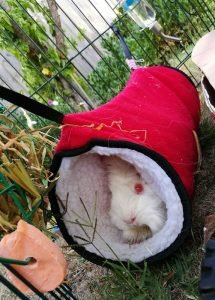 Guinea pig cages, guinea pig toys and accessories are all fundamental to owning happy guinea pigs as pets. Choosing the right guinea pig habitat is an important decision for both the comfort, health and safety of your new guinea pigs, as well as for your sanity when it comes to cleaning.
Guinea pig cages, guinea pig toys and accessories are all fundamental to owning happy guinea pigs as pets. Choosing the right guinea pig habitat is an important decision for both the comfort, health and safety of your new guinea pigs, as well as for your sanity when it comes to cleaning.
Guinea pigs grow to about 20-25cm in length and about 0.7-1.2kg in weight. Although they are cute and small creatures, they need adequate space for healthy happy living. As a rule of thumb, each guinea pig requires a minimum floor space of 1.0m x 0.5m with the height of the side barriers to be at least 30cm high to ensure the guinea pig is safe and does not climb out. Guinea pigs are social animals requiring companionship, so please adopt at least two guinea pigs. Depending on the number of guinea pigs being housed, you will need to multiply the space required by the number of guinea pigs. So, for two guinea pigs, they will require a minimum floor space of 1.0m x 1.0m. Of course, as guinea pigs need room to exercise and run around, the larger the space the better.

Within the guinea pig enclosure, there needs to be covered sleeping areas, one hidey hole per guinea pig for feeling of security and shelter, eating areas (which also tends to be where guinea pigs toilet) and play area with provision of toys to chew on and roll around for stimulation. If at all possible, set up a loft area with a ramp. Guinea pigs are intelligent and inquisitive animals, which will learn to use ramps. This is both good for stimulation and exercise. As they love to eat, a good way to train guinea pigs to use the ramp is to set up their eating area in the loft, encouraging them to explore the use of the ramp. It is important not to make the angle of the ramp too steep, ideally no more than 30 degrees incline if space permits. With either an indoor guinea pig cage or outdoor guinea pig hutch, make sure the design has easy access to all areas and allows for easy cleaning, e.g. via additional swing doors or litter trays that can be removed for cleaning.
Guinea pig enclosures need to be fly-proof, as they are susceptible to flystrike which can be fatal. Depending on where your guinea pigs are housed, they may require mosquito netting or fly wire installed. Guinea pigs are also very susceptible to heat stress, which again can be fatal and are best kept in well ventilated areas with temperatures around 18-26°C. Whether indoor or outdoors, guinea pig enclosures need to be away from direct sunlight, strong winds and must have adequate shady areas. Guinea pigs in outdoor hutches can also easily die from overheating. Having poor eyesight, guinea pigs have sensitive hearing and prefer a quieter environment.

Deciding on whether your guinea pigs will be indoor or outdoor pets will depend on your personal circumstances. Being prey animals, guinea pigs housed in indoor guinea pig cages of an adequate size are protected from possible predators such as cats, dogs, foxes and other animals that may be in the neighbourhood. Indoor guinea pig pets are also largely shielded from flies, as well as having a much more stable temperature controlled environment. Guinea pigs are social creatures and thrive on daily contact with their humans, which makes for happy and healthy guinea pigs.
